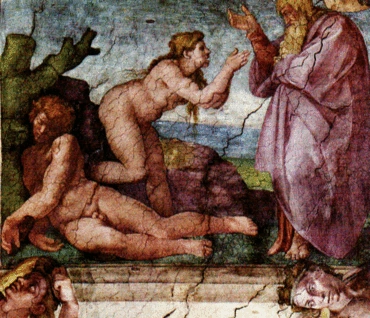Explanation of Genesis 2:22
За Brian David

The Lord is life itself. We are recipients of life. We give life unique forms because of our unique shapes as receptacles, and through free will we can choose how fully we will receive life. But we don't have life of our own. It follows from this that the more we turn toward the Lord and receive life, the more alive we will be; and the more we turn away the more dead we will be. It also follows that believing life is our own – with all the loves, the thoughts and the power that entails – is actually the antithesis of life.
This is the state of those in the deepest hells, who reject everything of the Lord, even His existence, and claim all life as their own. They are, in fact, only alive because the Lord forces life on them in the amount necessary to sustain existence.
This is, in a sense, what is represented by the rib – which is human, and is alive, but only in the most limited way. When the people of the Most Ancient Church (Adam) wanted to lead themselves and sense life as their own, the Lord had to use that most dead aspect of them to grant their wish. He had to use that bone, which represents our most hellish potential, what we would be if we were to reject the Lord completely.
But then the Lord did something miraculous. He turned that bone into living flesh, into a new person: the woman Eve. This represents that the Lord built that most dead, most hellish aspect of us up into something which felt life as its own, but could acknowledge that life actually came from the Lord, and could thus again be a recipient of life. It wasn't quite as pure as before; people could no longer commune directly with the Lord. But they had what they wanted instead: a sense of self.
The Writings call this – both the rib and the woman – by the Latin word proprium, essentially meaning "as of self." The rib represents the proprium on its own, which is hellish. The woman represents the proprium given life by the Lord.
(Посилання: Arcana Coelestia 151, 152, 153, 154, 155)
Arcana Coelestia #851
851. That 'the ark rested' means regeneration becomes clear from the fact that 'the ark' means the member of this Church, and all that was in the ark means all that resided with that member, as shown extensively already. When therefore the ark is said 'to rest' it means that this member was being regenerated. The train of thought in the sense of the letter does indeed seem to imply that 'the ark's resting' means that the fluctuations following temptation, dealt with in the previous verse, have come to an end. But fluctuations, which are doubt and haziness concerning truths and goods, do not in that manner come to an end but persist for a long time, as will also be clear later on. From this it is clear that the continuity of thought in the internal sense is different. The substance of that thought, being arcana, can be revealed here, namely this: After he has undergone temptations the spiritual man becomes the Lord's 'rest' in the same way as the celestial man does. In the same way also he becomes 'the seventh', not however the seventh day, as the celestial man does, but 'the seventh month'. For details concerning the celestial man's being the Lord's rest or sabbath, and the seventh day, see 84-88. But as a celestial man and a spiritual man are different from each other the celestial man's rest is expressed in the original language by a word meaning the sabbath, whereas the spiritual man's rest is expressed by a different word, from which the name Noah derives which specifically means rest.






